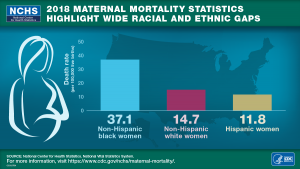Jul
14

Posted by Margot M on July 14th, 2020
Posted in: NIH
Tags: health disparities, maternal mortality, NIH

Image from womenshealth.gov.
During the time I was writing this blog post, I saw a news headline that British YouTube star Nicole Thea died at the age of 24. The article stated that she was eight months pregnant. We do not know the cause of her death. We do know that, as a Black woman, Nicole Thea was at risk for maternal death.
In May 2020, I attended a virtual conference on Pregnancy and Maternal Conditions that Increase Risk of Morbidity and Mortality. This NIH VideoCast was sponsored by the Eunice Kennedy Shriver National Institute of Child Health and Human Development, Office of Research on Women’s Health, National Heart, Lung and Blood Institute and the Office of Disease Prevention.
According to the Centers for Disease Control and Prevention:
Maternal mortality is an important health indicator, and correctly identifying and reporting maternal deaths has been a longstanding challenge. A maternal death is defined as, “the death of a woman while pregnant or within 42 days of termination of pregnancy,” but excludes those from accidental or incidental causes. The national maternal mortality rate (MMR) in 2018 was 17.4. The rate for non-Hispanic black persons in 2018 was more than twice that for non-Hispanic white persons, 37.1 compared with 14.7. Rates also increased substantially by age, with rates for women aged 40 and over roughly eight times the rate for women under 25 (81.9 and 10.6, respectively).
Please see the CDC for details.

The US data shows us that Black women are at higher risk of maternal death. Weathering, a term given to us by public health researcher Arline Geronimus, is increasingly evident as a major stressor for Black women, leading to increased allostatic load. Allostatic load refers to wear and tear on the body due to chronic stress.
The responsibility for reducing maternal death falls largely to the health care system, according to this Report from Nine Maternal Mortality Review Committees. In about one-third of the cases, patients lacked awareness of the warning signs. Raising awareness among Black women is not enough. Even when patients are aware, this report offers ample evidence that health care providers fail to diagnose or effectively treat Black women. Patients encounter a health care system with inadequately trained personnel, inadequate policies and procedures, and inadequate communication between providers who are caring for Black women.
The two-day virtual conference, available for viewing through the NIH VideoCast website, covered multiple causes of maternal death. Black women are at increased risk for all of these conditions. As stated by many of the researchers, we need to understand how racism is impacting the health of Black women and girls throughout their lifespans.
Two years ago, singer-songwriter and actress Beyoncé revealed that she suffered from preeclampsia during pregnancy. Preeclampsia is a multi-systemic syndrome–a cardiovascular disease that potentially involves liver or kidney damage. Many people associate preeclampsia with hypertension, yet researchers are considering that this condition could possibly exist without hypertension. Most deaths due to preeclampsia and eclampsia happen during postpartum, disputing the belief that birth will “cure” these pregnancy-related conditions.
Tennis superstar Serena Williams experienced a pulmonary embolism during postpartum. Pulmonary embolism is a Venous Thromboembolic Disorder. The 2019 review, Venous thromboembolism as a cause of severe maternal morbidity and mortality in the United States. found that deaths due to pulmonary embolism account for 9.2% of all pregnancy-related deaths. The article states that maternal deaths are more common among women who deliver by Cesarean section. Black women, as well as older mothers and women with co-morbidities, are at higher risk of Venous Thromboembolic Disorders. Despite her physical fitness, Serena Williams was at risk.
Check out these resources from the Network of the National Library of Medicine.
Black Maternal Health Suggested Readings
Anti-Racism in Graphic Medicine
Black/African American Health Resources